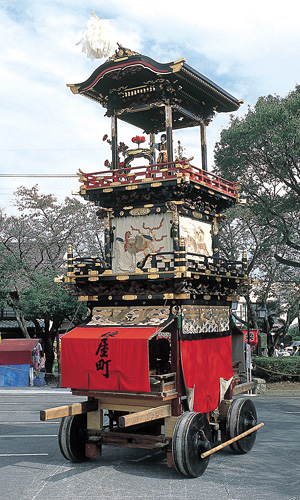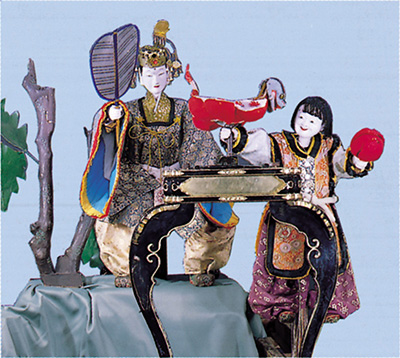 車山とからくり
車山とからくり
練屋町の車山

◆國香欄(こっこうらん)
唯一、上山の欄干が朱塗りになっているとともに、中山の幕(中幕)の正面に 大房を掛けていないことが特徴の車山。 大房については、中幕そのものが四神、古代中国で、天の四方をつかさどるとされた神。東の青竜(せいりゅう)、西の白虎(びゃっこ)、南の朱雀(すざく)、北の玄武(げんぶ)を配して、幕そのものが魔 除け幕であると昔から言い伝えられているためである。彫り物は「無双彫り」と 言われる彫りの深い作りで、上山の鶴・ 中山の龍・下山の獅子が一八四二年に製作された。からくりは能楽の石橋を元にしており、一七四二年に作られた文珠菩薩を今もそのまま使用している。
◆Kokkoran Yama (Neriyacho Precinct)
Only this yama has a red lacquered handrail on the upper deck. Also in lieu of tassels on the middle deck tapestry, images of four gods, the Blue Dragon, the White Tiger, the Red Bird, and the Black Turtle-Snake, serve as a talisman. The deep carvings on each deck are matchless. They are of a crane on the upper deck, a dragon on the middle, and a lion on the lower. They were made in 1842. The story of this karakuri comes from a Noh play. The main karakuri, Monju, was made in 1742.
練屋町のからくり人形

◆石橋獅子(しゃっきょうじし)
車山名「国香」とは国を代表する花の香りを意味し古来中国では牡丹の事です。上山の勾欄が朱色であることから国香欄と名付けられました。からくりは人形2体による糸からくりで、古くからある獅子舞に「十訓抄」所載の寂昭法師入唐のことをおりまぜた能楽「石橋」・・・寂昭が中国の清涼山という仙境にたどり着き、その先には細く長い石橋が架かっている。石橋を渡れば文殊菩薩の浄土であるが尋常な修行では渡れない。そこで、寂昭法師が拝むと文殊菩薩の精である獅子があらわれ奇跡的に渡ることができた・・・に基づいて作られています。楽の音に合わせ、唐子人形の操りで始まり、牡丹の花を手に嬉々として文殊人形の面前で踊り戯れる中に花台(猫足の唐台)の上に牡丹の花を挿すと、花が咲いたかと見る間に花の中から獅子頭が跳び出し頭と尾をふりふり跳ね回り、そのさまを眺めていた文殊人形が軍配を片手に唐子をほめ称えられ、千秋万歳を寿いで舞い納めとなります。その表情が実に楽しくみえます。石橋は歌舞伎にも取り入れられ、連獅子の源となっている。
◆Shakyo Jishi (A lion on a bridge)
Kokko is a word used to describe the scent of a countrys National Flower. In ancient China this applied to peonies. This float is named Kokkoran as the red lacquered handrails on the upper deck are suggestive of red peonies.
On this float there are two karako operated by sting that perform the Noh play Shakyo. In the story a high-ranking priest named Jakuso visits China. Jakuso approached the entrance of paradise on Mt. Seiryo. In front of him is a long, narrow stone bridge where a Buddhist monk named Monjubosatsu lives. It is thought that it is impossible for someone without special training to cross the bridge.
Jakuso stands at the base of the bridge praying. Monjubosatsu appears in front of him in the shape of a lion and allows him to cross over the bridge safely.
With music playing the karako begins to dance. The karako joyfully dances in front of Monjubosatsu while holding a peony, which it places on the pedestal. The peony begins to grow larger before suddenly stopping and a lion jumps up out of the pedestal. The lion wags its head and tail while jumping around. After watching for a little while Monjubosatsu gets up and joins the lion while dancing around and waving a fan. Monjubosatsu praises the karako and wishes everyone in the audience a long life.
This story became the origin for the kabuki play Renjishi (A string of lions).